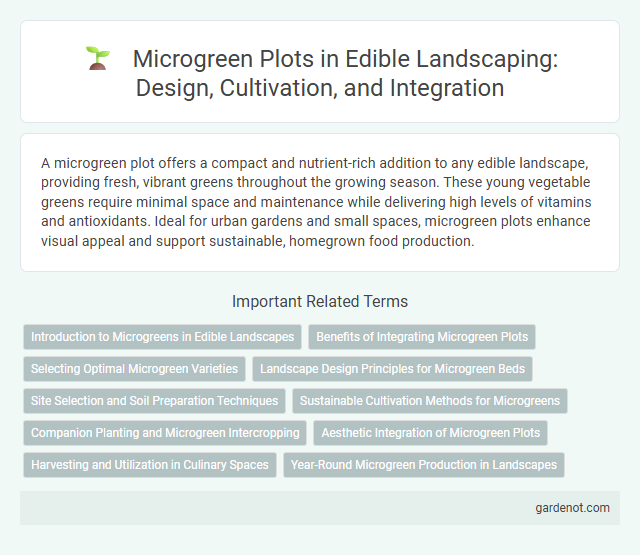A microgreen plot offers a compact and nutrient-rich addition to any edible landscape, providing fresh, vibrant greens throughout the growing season. These young vegetable greens require minimal space and maintenance while delivering high levels of vitamins and antioxidants. Ideal for urban gardens and small spaces, microgreen plots enhance visual appeal and support sustainable, homegrown food production.
Introduction to Microgreens in Edible Landscapes
Microgreens are young, vibrant seedlings harvested shortly after germination, offering dense nutritional value and intense flavors ideal for edible landscapes. Integrating microgreen plots into edible landscapes maximizes space efficiency while enhancing visual appeal with diverse textures and colors. Cultivating microgreens supports sustainable food production through quick growth cycles and minimal resource requirements.
Benefits of Integrating Microgreen Plots
Integrating microgreen plots within an edible landscape enhances nutritional value by providing a dense source of vitamins, antioxidants, and minerals in a compact space. These fast-growing greens support biodiversity, improve soil health through minimal cultivation needs, and reduce the carbon footprint by enabling local, home-grown food production. Their versatility allows for year-round harvesting, boosting food security and culinary variety in sustainable garden designs.
Selecting Optimal Microgreen Varieties
Selecting optimal microgreen varieties hinges on factors such as growth rate, nutrient density, and flavor profile to maximize yield and culinary appeal. Fast-growing species like radish, sunflower, and pea shoots provide robust nutrient content and vibrant flavors suited for edible landscapes. Prioritizing disease-resistant and adaptable microgreens ensures consistent harvests and reduces maintenance in diverse environmental conditions.
Landscape Design Principles for Microgreen Beds
Microgreen plot design integrates landscape design principles such as spatial arrangement, scale, and texture to maximize visual appeal and functional yield. Utilizing raised beds or modular trays facilitates optimal sunlight exposure and accessibility, enhancing plant health and growth. Incorporating complementary plant varieties and color contrasts improves biodiversity and creates dynamic, aesthetically pleasing edible landscapes.
Site Selection and Soil Preparation Techniques
Choosing a microgreen plot requires selecting a site with ample natural light, preferably 4 to 6 hours of direct sunlight daily, and well-drained soil to prevent waterlogging. Preparing the soil involves loosening it to improve aeration, incorporating organic compost for nutrient enrichment, and ensuring a pH between 6.0 and 7.0 to optimize microgreen growth. Proper site selection and soil preparation significantly enhance germination rates and yield quality in edible landscape microgreen cultivation.
Sustainable Cultivation Methods for Microgreens
Sustainable cultivation methods for microgreens emphasize soil health, water efficiency, and organic inputs to reduce environmental impact. Techniques such as using biodegradable growing mediums, rainwater harvesting, and integrated pest management optimize resource use while maintaining high nutritional quality. Implementing vertical farming systems and renewable energy sources further enhances energy conservation and supports year-round production in edible landscapes.
Companion Planting and Microgreen Intercropping
Microgreen plots thrive using companion planting techniques that pair compatible species to enhance growth, pest resistance, and nutrient uptake. Intercropping microgreens such as radish with cilantro allows efficient space use and diverse harvests while improving soil health. Strategic microgreen intercropping in edible landscapes boosts yield and biodiversity, creating a resilient and productive growing system.
Aesthetic Integration of Microgreen Plots
Microgreen plots enhance edible landscapes by adding vibrant textures and colors that seamlessly blend with surrounding plants, creating visually appealing garden compositions. Strategic arrangement of microgreen varieties with contrasting hues and leaf shapes maximizes aesthetic impact while promoting biodiversity. Incorporating microgreens into ornamental beds or kitchen gardens elevates both visual interest and functional food production.
Harvesting and Utilization in Culinary Spaces
Harvesting microgreens requires precise timing, typically 7 to 21 days after germination when the cotyledon leaves fully open, to maximize nutrient density and flavor profile. Culinary spaces utilize freshly harvested microgreens to garnish dishes, enhance salads, and infuse vibrant flavors and textures in sandwiches and soups. Efficient microgreen plot management ensures a consistent supply of high-quality greens, boosting menu creativity and nutritional value.
Year-Round Microgreen Production in Landscapes
Year-round microgreen production in edible landscapes enhances food security by providing a continuous supply of nutrient-dense greens regardless of season. Integrating microgreen plots in residential and urban gardens optimizes space and supports sustainable agriculture through reduced water usage and minimal pest control requirements. Leveraging controlled environment techniques ensures consistent growth cycles, making microgreens an efficient and versatile addition to home and commercial landscapes.
Microgreen plot Infographic

 gardenot.com
gardenot.com